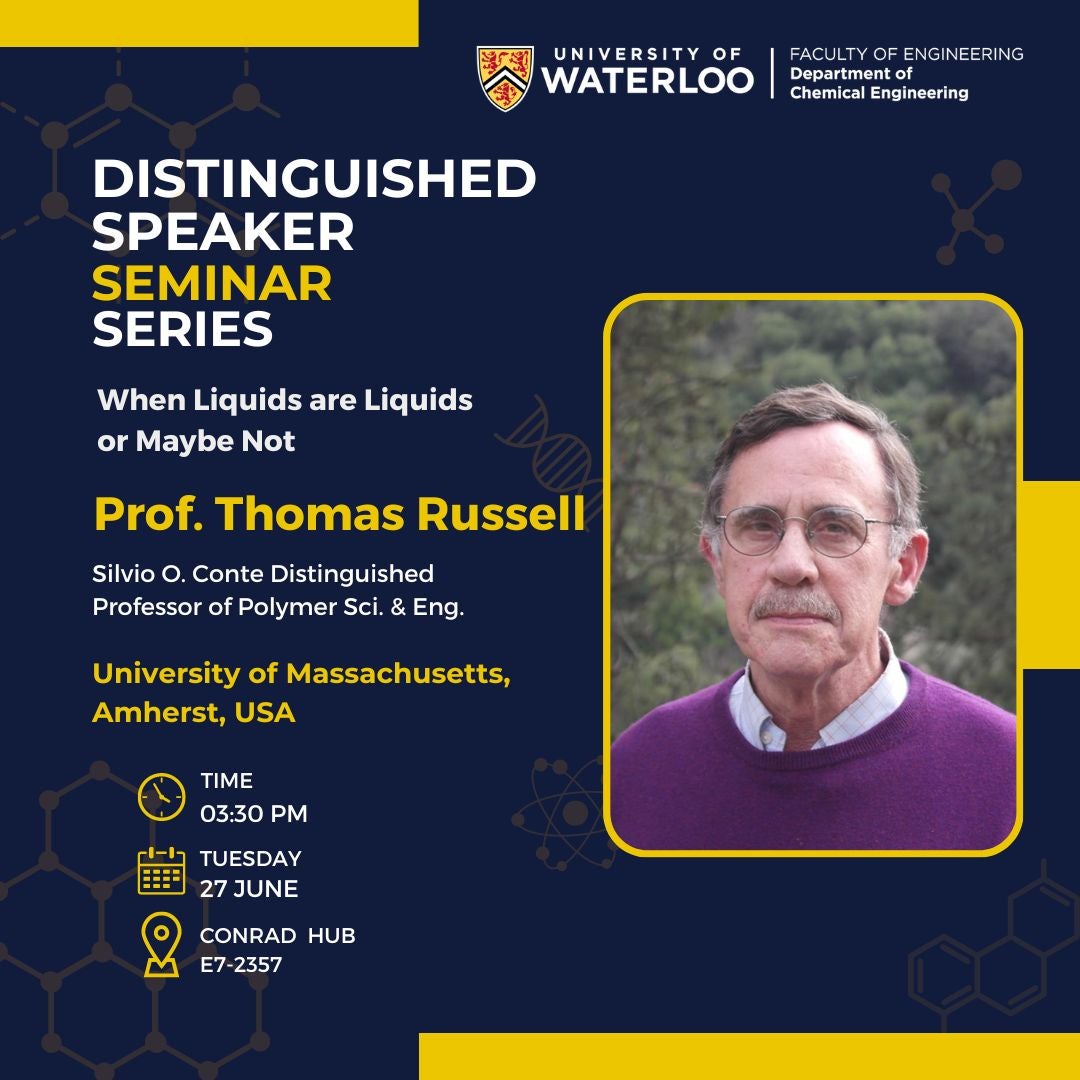Distinguished Speaker Seminar Series| When Liquids are Liquids or Maybe Not, by Professor Thomas Russell

Distinguished Speaker Seminar Series| When Liquids are Liquids or Maybe Not, by Professor Thomas Russell
Abstract: We introduce systems of liquids, trapped in non-equilibrium configurations by the jamming of interfacial assemblies of nanoparticle surfactants (‘NPSs’). These constructs consist of aqueous tubules,
~10-100 cm in length and ~100 m in diameter whose mechanical properties are determined by an interfacial NPS assembly 20 nm thick. The interfacial layer consists of functionalized nanoparticles dispersed in an aqueous phase and polymers having a complementary functionality, that interact only at the oil-water interface, to generate NPS that are irreversibly bound to the oil-water interface. The shapes of the liquid phases can be extensively deformed and reconfigured while maintaining macroscopic structural integrity and are stable against coalescence. The films are also self-healing, so that any ruptures in the film are rapidly repaired. These structured liquids can be prepared using a wealth of different nanoparticles, including metallic nanocrystals, meaning the interface can be readily functionalized with the properties characteristic of the NPs. The liquids retain their fluid
characteristics: reagents can be flowed through them continuously, and they can be rendered responsive to external stimuli. In the case of paramagnetic nanoparticles, the interfacial jamming of the NPs in a magnetic field can transform an initial ferrofluid droplet into a ferromagnetic liquid droplet, producing a completely new form of magnetic material. If the paramagnetic NPs are overpacked at the interface, storing a potential energy, an explosive spontaneous emulsification occurs, jettisoning ferromagnetic liquid droplets from the interface at velocities exceeding 1 m/s. Potential applications of structured liquid include biphasic reaction medium and responsive, self-regulating systems whose internal environment can be readily altered.
Biography: Thomas P. Russell, the Silvio O. Conte Distinguished Professor of Polymer Science and Engineering at the University of Massachusetts in Amherst, received his PhD in 1979 in Polymer Science and Engineering from the University of Massachusetts Amherst, a Research Associate at the University of Mainz (1979-1981), a Research Staff Member at the IBM Almaden Research Center in San Jose, CA (1981-96). He is also a Visiting Faculty at the Materials Science Division in the Lawrence Berkeley National Laboratory, an Adjunct Professor at the Beijing University of Chemical Technology, and a PI at the Advanced Institute of Materials Research at Tohoku University. His research interests include the surface and interfacial properties of polymers, phase transitions in polymers, directed self-assembly processes, the use of polymers as scaffolds and templates for the generation of nanoscopic structures, the interfacial assembly of nanoparticles and wrinkling of thin polymer films. He was the Director of the Materials Research Science and Engineering Center from (1996-2009), Director of the Energy Frontier Research Center on Polymer-Based Materials for Harvesting Solar Energy (2009-2014), a PI in the Global Research Laboratory at Seoul National University (2005-2015), and the Beijing Advanced Innovation Center on Soft Matter (2016-present). He has over 1,000 publications, 40 patents and edited 5 books. He is a Fellow of the American Physical Society, Materials Research Society, Neutron Scattering Society of America, American Association for the Advancement of Science, and the American Chemical Society, Polymer Materials Science and Engineering Division. He has received the Polymer Physic Prize of the APS, the Cooperative Research Award of the ACS, the Dutch Polymer Award, the ACS Award in Applied Polymer Science, Society of Polymer Science Japan International Award, and is an elected member of the National Academy of Engineering and the National Academy of Inventors